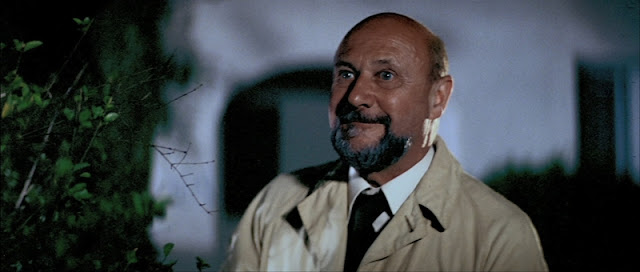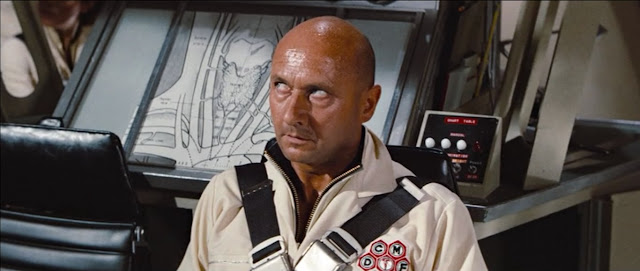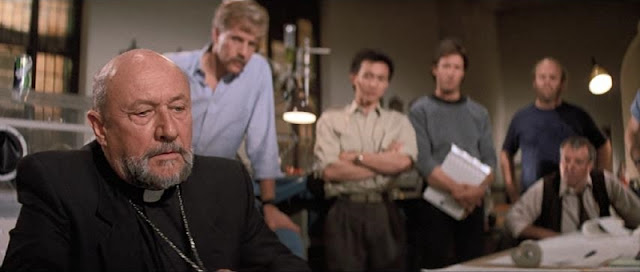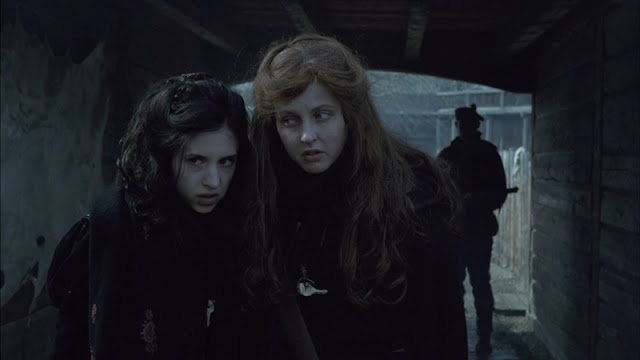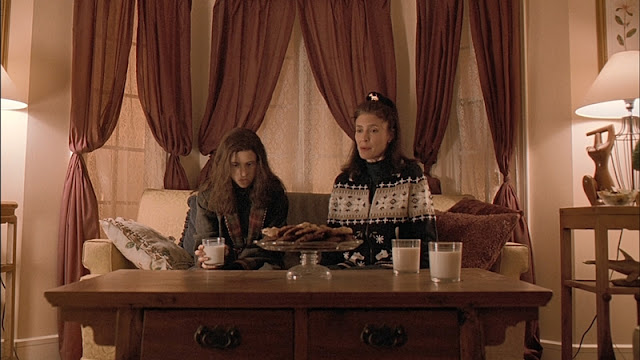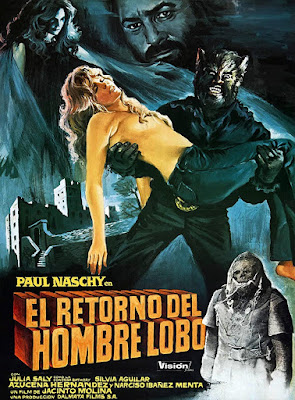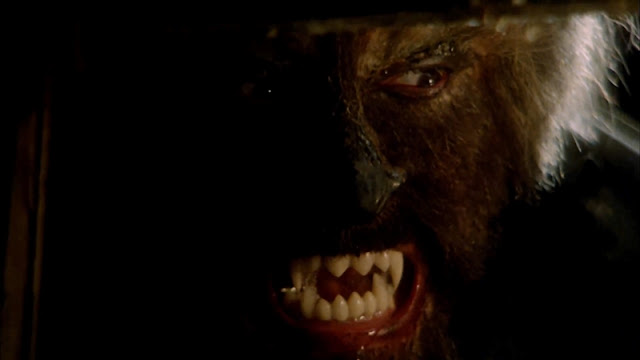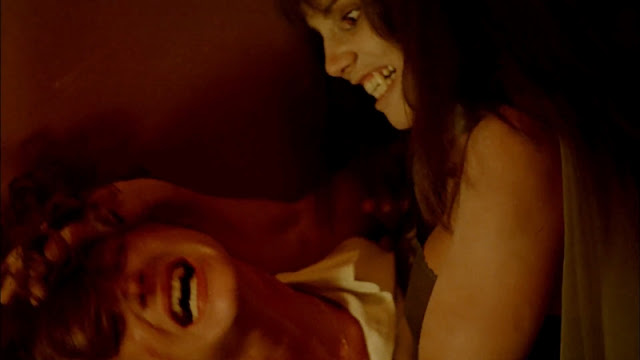“The goal was to create a werewolf movie that no one had
seen before. It was to kind of take people’s expectations of the genre, and
then… bend them and twist them, and really make it something that was a
departure. I really wanted to strip the magic away from the werewolf, and
create the werewolf as a kind of a biological entity. The werewolf was a virus
that infected the human body…” - John Fawcett (Director, Ginger Snaps)
Aroooo… Ho hum. There’s a certain sameness to many werewolf
movies: Man gets bitten by werewolf and subsequently acquires curse, man
transforms into werewolf, followed by man living a tortured existence until he
meets a tragic ending. Sure, there’s infinite possibilities within these
confines, but most permutations seem to follow a similar trajectory, with
predictable results.
The first Ginger Snaps movie (which seemingly sprung
from nowhere) was just the shot in the arm the genre needed, managing to be a
clever twist on coming-of-age comedies and werewolf flicks in one go. It was a refreshing
departure from the usual male-centric genre offerings, which typically portrayed
men as the problem-solvers and women as passive and virtually extraneous
(except, perhaps, as sex objects). Instead, the men are often depicted as ineffectual
or toxic (or a combination of both).
How do you follow up a successful film? The usual sequel
formula involves upping the action and raising the stakes, while making
everything louder, faster and more bombastic. The Ginger Snaps sequels are a surprising exception,
despite featuring different writing/directing teams (which usually isn’t a good
sign). Then again, the changing of the guard created a unique tone for each
film, as well as providing an opportunity to take the two principal characters
in unexpected directions.
Ginger Snaps (2000)
Directed by John Fawcett; Written by Karen Walton; Story by John Fawcett;
Starring: Emily Perkins, Katharine Isabelle, Kris Lemche, Mimi Rogers and Jesse
Moss; Available on Blu-ray and DVD
Rating: ****
“A girl can only be a slut, a bitch, a tease, or the virgin next door.” – Ginger (Katharine Isabelle)
Ginger Snaps was barely a blip on the radar when it debuted
in Canadian theaters. After it failed to score a distribution deal in the States,*
director John Fawcett feared that was the final nail in the coffin for his
independent werewolf flick. A screening in New York breathed new life into his
movie, and it was subsequently picked up by HBO, where it enjoyed heavy
rotation. Thanks to home video and positive word of mouth, the
little-werewolf-movie-that-could grew to become a cult favorite, as well as a
modern genre classic.

Gawky teen sisters Ginger and Brigitte* (Katharine Isabelle
and Emily Perkins) share an odd sort of symbiosis. Not unlike the eponymous
Harold from Harold and Maude, Ginger and Brigitte enjoy staging brutal
deaths and filming them – the more revolting, the better. Their long-suffering parents,
Pamela (Mimi Rogers) and Henry (John Bourgeois) have come to begrudgingly tolerate
their stunts as some sort of weird phase. Being late to the puberty party,
they’re further isolated from their high school** peers, so they stick together
as one death-obsessed unit, with outgoing Ginger and reclusive Brigitte against
the world. But for Ginger, at least, she’s about to undergo a radical
transformation. After she’s viciously attacked by a wolflike creature, her body
seems to be making up for lost time, as she experiences her first period, and
boys begin to take notice of her appearance. The dyad between the sisters begins
to splinter, as Ginger begins to discover boys, while wielding her newly discovered
sexual charms. But puberty is only the beginning for Ginger, as her body has
new, monstrous changes in store. Brigitte becomes increasingly alarmed at her
sister’s metamorphosis, and is determined to find a cure.
* Fun Fact #1: Just after casting Perkins as Brigitte,
Fawcett was chagrined to learn that she had cut her hair extremely short. His less-than-elegant
solution was to put her in a wig.
** Fun Fact #2: The various high school PA announcements
throughout the film were done by an uncredited Lucy Lawless. At one point, she
pages the “Raimi twins, Samuel and Theodore,” to the principal’s office, a fun
reference to her longtime working partnership with Sam and Ted Raimi.
Mimi Rogers’ amusing supporting performance as the sisters’
peppy but clueless mother Pamela, is well worth noting. She sports one tacky
outfit after another (selected by Rogers, herself), and her default coping
method for a life-changing event is to bake something. There’s unexpected depth
to Pamela (unlike her obtuse husband), as she gets wise to some of the strange
and awful things that are occurring around town.
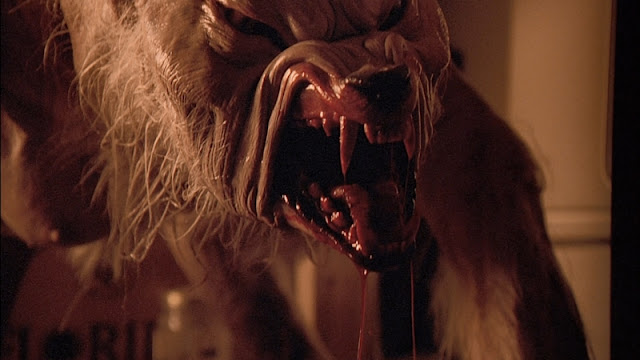
Director Fawcett aimed for a monster that seemed biologically
plausible, rather than a product of some magical process. Other than lunar phases
being associated with menstrual cycles, the filmmakers didn’t want the moon
linked to Ginger’s transformation.* Compared to their hirsute cousins in nearly
every other werewolf film, the beasties in this movie were mostly hairless
(featuring makeup effects by Paul Jones). Also, unlike most other werewolf depictions,
changing into the mythical beast is a one-way street – there’s no reverse
transformation from werewolf to human. Likewise, screenwriter Karen Walton
wanted veracity in her teen characters. As a result, the characters sound like flesh
and blood teens, rather than some idealized Hollywood construct. Walton equates
lycanthropy with teens becoming something monstrous, as the culmination of a
self-destructive lifestyle.
* Fun Fact #3: Fawcett joked that it was the first werewolf
movie without a shot of the full moon. Although I can’t confirm the veracity of
that statement, it’s safe to say few other filmmakers would dare to omit an
obligatory shot of the full moon in their werewolf movies.
If Heathers had been filmed by David Cronenberg,* it
might look something like Ginger Snaps. It’s an inspired mix of the
comic and the grotesque with an insightful study of human nature, deftly
balancing the drama with well-timed comic moments (Walton’s ear for how people
talk runs circles around the sequels in the dialogue department). As an intentional
departure from genre stereotypes, Ginger Snaps thumbs its muzzle at
werewolf lore, while honoring its horror roots, making this an essential
addition to the sub-genre.
* Fun Fact #4: Fawcett and Walton cited several films as the
inspiration for Ginger Snaps, including Carrie, Heavenly
Creatures, and the films of fellow Canuck, Cronenberg (especially Dead
Ringers and The Fly).
Ginger Snaps 2:
Unleashed (2004) Directed by Brett Sullivan; Written by Megan Martin;
Characters by Karen Walton; Starring: Emily Perkins, Brendan Fletcher,
Katharine Isabelle and Tatiana Maslany; Available on Blu-ray and DVD
Rating: ***
“You’re healing faster, aren’t you? That shit’s not a cure,
you know. It just slows the transformation. It doesn’t stop it, B. Nothing will
stop it.” – Ginger (Katharine Isabelle)
It must have been a daunting task following up one of the
most original werewolf movies in years, but director Brett Sullivan and writer
Megan Martin did an admirable job with Ginger Snaps 2: Unleashed. This
time, the focus is on Brigitte, who’s become increasingly withdrawn from society,
following the aftermath of the first film. Now afflicted with the same curse as
Ginger, the only thing that keeps her transformation at bay is a solution of poisonous
monkshood (a relative of wolfsbane), which she injects on a regular basis. Her escalating
self-destructive behavior eventually leads her (unwillingly) to a rehab center
for young women.

If the first film is about lycanthropy as a metaphor for
puberty, the second concerns werewolves standing in for the ravages of
addiction. Brigitte has become sickly and gaunt, waiting for her next fix of an
antidote that isn’t really an antidote. Haunted by the threat of turning into a
werewolf, she starts shooting up with greater frequency, but it appears to have
a diminishing effect. She finds little solace in her visions of Ginger
(reprised by Katharine Isabelle), who mercilessly goads her.

The film introduces some interesting characters, including Tyler
(Eric Johnson), a loathsome orderly who gives the inpatients the drugs they
crave, in exchange for sexual favors. A strange young girl, known only as Ghost
(Tatiana Maslany), follows Brigitte around the facility, narrating everything
that’s going on, as if she’s writing a story. With Ginger out of the picture, there’s
a reversal of roles, with Brigitte standing in as the unwitting surrogate older
sister. As we soon learn, however, there’s more to Ghost than Brigitte first
suspects.

The creature effects, employed sparingly, are handled by KNB
Effects Group. Instead of the mostly hairless creatures in the first film, the
werewolves have a more traditional, furry appearance, which carries over to the
third film (also featuring KNB Effects). The annoying rapid-cut shock scenes (especially
ubiquitous in the early 2000s) are distracting rather than engaging. It’s
disappointing, albeit unsurprising, that Ginger Snaps 2 doesn’t have as
much to say as the first movie. Although it’s more like an epilogue to Ginger
Snaps, rather than a fully satisfying sequel, it ultimately gets more right
than it does wrong.
Ginger Snaps Back: The
Beginning (2004) Directed by Grant Harvey; Written by Christina Ray and
Stephen Massicotte; Starring: Katherine Isabelle, Emily Perkins, Nathaniel
Arcand, JR Bourne, Hugh Dillon and Brendan Fletcher; Available on Blu-ray and
DVD
Rating: ***
“The English and the French brought with them their diseases
to plague our land. And with them came the Wendigo. This was all foretold.
Watched for. And with the Wendigo would come two sisters, the Red and the
Black. And their love and their deaths would decide the way of things.” –
Hunter (Nathaniel Arcand)
Instead of following the sequence of events in the first two
installments, the third Ginger Snaps movie regresses 200 years, to
Canada’s pre-history, focusing on Ginger and Brigitte’s ancestors (who conveniently
look identical and possess the same names). This time, the setting is a remote
outpost, surrounded by hostile assailants.
Ginger Snaps Back is essentially a siege film, taking
its inspiration from John Carpenter movies such as Assault at Precinct 13
and The Thing. A pervasive sense of dread and paranoia takes hold, as
the outpost’s occupants view outsiders Ginger and Brigitte with suspicion. Things
drag on a bit long, as we anticipate the inevitable bloody werewolf onslaught, but
arrive it does. In this film, the werewolf is an unstoppable supernatural force,
a manifestation of the Wendigo legend. A First Nations warrior (Nathaniel
Arcand, in an intriguing but underwritten role) protects the sisters from harm,
as he watches an ancient prophecy come to fruition.

Considering its meager budget, Ginger Snaps Back
boasts strong production values and some excellent cinematography. It’s too bad
the pacing, as well as the dialogue is so inconsistent. Much like the previous
installment, it’s a mostly humorless affair, with the witty exchanges of the
first film sorely missed. Ginger and Brigitte appear to be transplanted from a
different era, speaking contemporary English, while everyone else remains
entrenched in the early 19th century. Faults aside, it’s laudable
that the filmmakers avoided the easy route, choosing to take the third movie in
a completely different direction. Here’s hoping this isn’t the last adventure
of Ginger and Brigitte.
Sources: Shout Factory Blu-ray commentary by John Fawcett; “Ginger
Snaps: Blood, Teeth and Fur” (2014 documentary); “A Different Kind of Monster
Movie: Writer Karen Walton Reflects on Ginger Snaps 20 Years Later,” by
Tatiana Tenreyro, Bloody Disgusting


